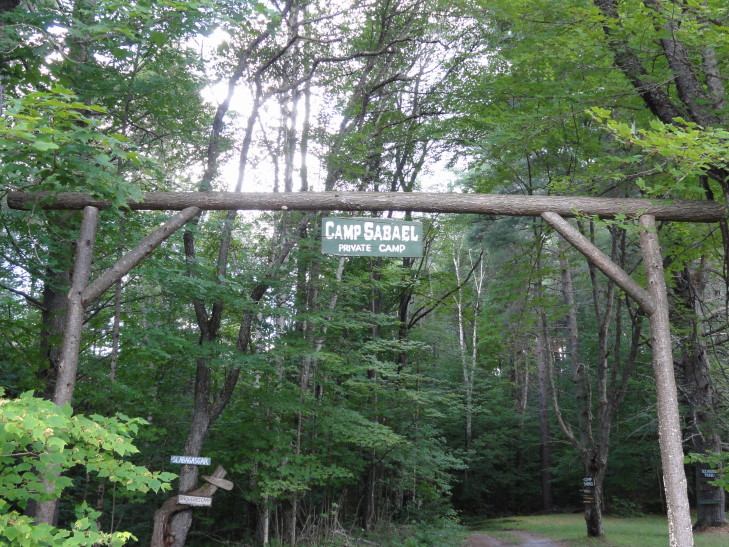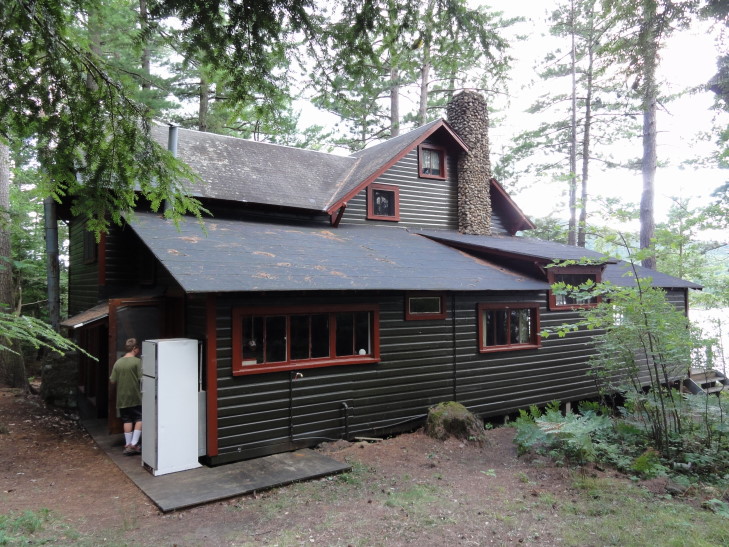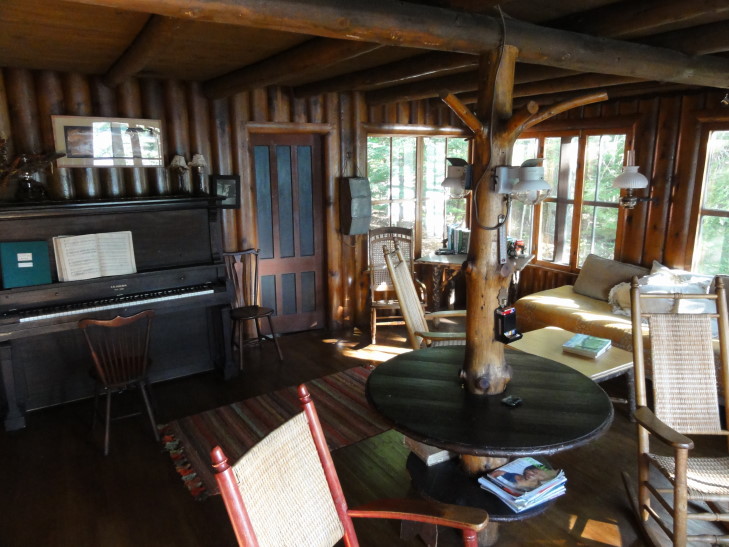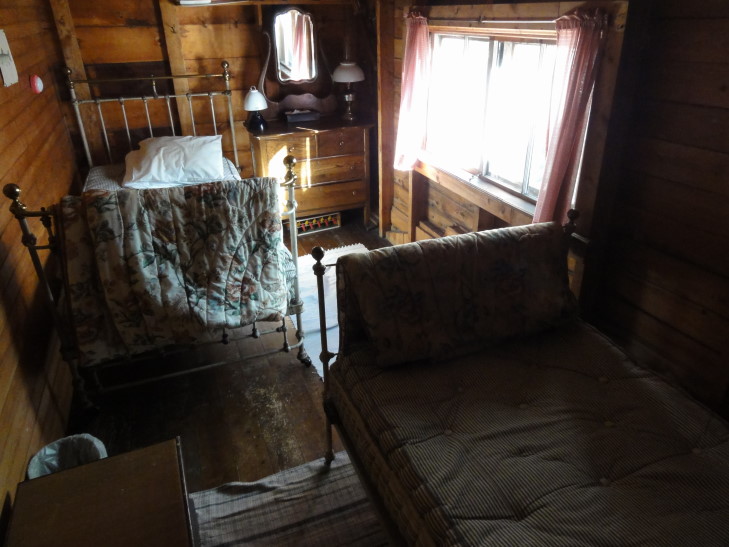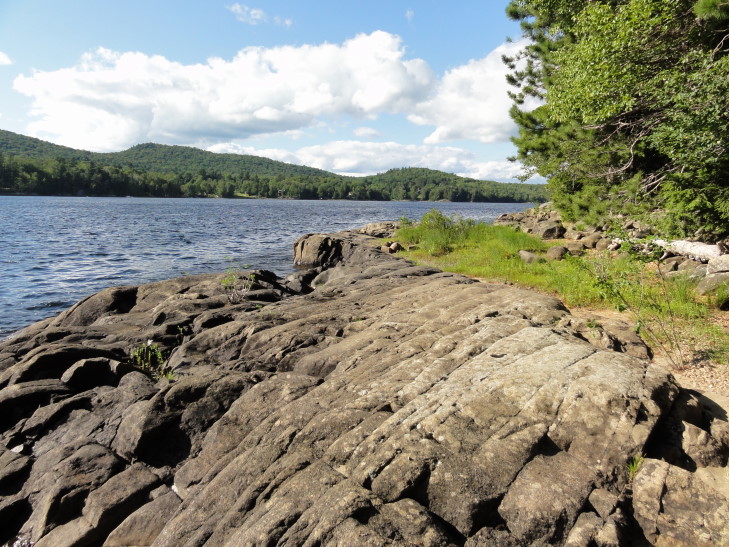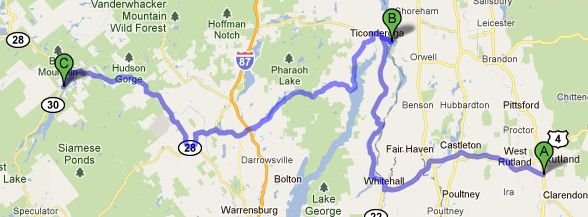Woke up and checked out ASAP from our room in the Rutland, Vermont Holiday Inn. The room smelled terrible, and what had been a cough the day before was a lot worse in the morning. However, I think whatever crud I caught (and it would only get worse) was not from the room — but it didn’t help either. The staff said “well, we changed it over from smoking a month ago…” Hey, here’s a clue: it takes WAY more than a month for a smoking room to not smell like an ashtray. While I sympathize with their problem — they can’t sell it as a smoking room if they want to transition it to a non-smoking room — I think the opposite, billing it as a non-smoking room, is dishonest at best. We’ll do our best to avoid Holiday Inn non-Express in the future — as it is the non-Express ones that seem to show this quite a bit.
Anyhow, went grocery shopping at the Hannaford Foods in Rutland. Man, there were a lot of older people — I suppose it is a retirement community? We picked up tons of supplies for Indian Lake: napkins, paper towels, toilet paper, plastic cutlery, food such as Entenmann’s (donuts, buns, and the required New York style crumb cake), grapes, blueberries, chips, cookies, etc. — stuff that would suffice for breakfast and lunch and not require refrigeration. While Michelle was checking out Addison and I happened to be perusing the 50c charity books section and we found a hardcover collection of stories with illustrations from one of Michelle’s favorite authors, Charles deLint, that she did not own. Score!
We then set out for Ticonderoga, stopping by McDonalds for some sweet tea. Now normally I’m not a huge proponent of the homogeneity that chain restaurants bring to the United States (and abroad), but… In an otherwise sweet tea-less land McDonalds is more than welcome.
After a very beautiful drive through the countryside of western Vermont and extreme eastern New York we arrived at Fort Ticonderoga. The fort played a pivotal role in the settling of the region as well as sorting out the balance of power between France and England in the 1700s. Originally Fort Carillon, a French fort, it guarded the entrances to both Lake George (the north side) and Lake Champlain (the south side). In 1758 there was a huge battle where a small number of French soldiers (around 4,000) under Montcalm (who would later die trying — and failing — to hold Quebec City in 1759) held off a vastly larger English force (around 17,000) by doggedly defending a hill to the northwest of the fort. The French defenders had, in about two days straight digging, erected an eight foot high barrier that was easy to defend and allowed them to hold out. They also got very lucky in that they managed to kill Lord Howe, considered to be the brilliant tactician of the English force, just before the fight. This battle would be the bloodiest day in North America until Antietam in 1862.
The following year, 1759, the British would take Fort Carillon and rename it Fort Ticonderoga, from the Iroquois “junction between two waterways.” In 1775 Ethan Allen’s Green Mountain Boys, along with Benedict Arnold, captured the fort and had the cannon hauled to the east to help with the war effort in Boston. The British recaptured it in 1777 but it became irrelevant after their defeat at Saratoga and was eventually abandoned. It lay in ruin, scavenged for years by people for building material, until preserved and later restored in the 1800s and 1900s.
The fort today makes quite an impression. There are three buildings in the center that surround a courtyard, then the walls themselves, then two triangle shaped defensive-works, one to the west, one to the north. These are connected to the main walls by wooden bridges that could be destroyed should one of the triangles be taken — and cannon could be brought to bear against them. The fort has commanding views of both the upper reaches of Lake George and the lower reaches of Lake Champlain and is surrounded by mountains (which would prove to be an Achilles heel).
We watched and listened to a fife & drum corps, in United States uniform, enter the fort via the entry tunnel and parade about the courtyard. Then we watched an excellent introductory film that laid the groundwork for what we were seeing and took in the exhibits in the two other buildings.
The largest building had many things from the fort, the campaigns, etc. Lots of old maps and such, including such interesting stuff as Georgia as a colony splitting South Carolina into an upper and lower colony — the upper being where South Carolina is today (though extending westward to the Mississippi) and the lower being just north of St. Augustine, Florida, and extending west. Also interesting was a map referring to New York as New Belgium. I knew that the Dutch were the original European power to take New York but had no idea that the land was referred to as New Belgium at one point! There were also exhibits on everyday soldiers’ items and the like, and a diorama of the Black Watch, a Highlander regiment that took horrific losses (over half) during the Battle of Carillon in 1758. Particularly stirring was a page from the book that listed all of the British Army officers with, in pencil, “Kd” or “W” marked next to nearly every officer from the Black Watch — for “killed” or “wounded.”
The other building had a large collection of muskets, swords, and other weaponry from the period, including one musket that had a nasty exploded breech that surely killed its owner. The kids took turns holding a reproduction firearm to get a feel for the weight of the things.
Once back in the main courtyard we listened to another fife and drum corps, this time in British regalia, play various songs that dictated the activity about camp. This was in the day before wristwatches and the like and the common soldier could not afford watches. The fife and drum corps would play various songs, not only to announce the time but also what the soldiers should be doing. One song told them to get to work, then when to break, then to get back to work, then when to break for the day. Another would rouse them in the morning. That sort of thing.
We also took in a small exhibit on feeding the soldiers at the fort. We learned that it took a shift of bakers working twenty-four hours a day to make enough bread for the garrison. There was a garden maintained during the spring and summer months, before the snows set in. A variety of foods were eaten, everything from clams to pork to beef and fish. And, as can be expected, the officers ate far better than the rank-and-file.
As for us, we left the fort and ate hotdogs and grilled cheese sandwiches at the gift shop adjacent to the fort. Did a bit of shopping and headed out to Indian Lake around 3p.
We arrived at Camp Sabael, on the upper eastern shore of Indian Lake, at about 4p. Camp Sabael, and in particular our cabin of Gray Rock, is very important to the Young family. While the Camp was founded in the late 1800s it wasn’t until 1908 that the Youngs, on the recommendation of the Colwells, joined Camp Sabael and built their own cabin. The patriarch of the family at that time, James Addison Young (or “The Judge” as he was frequently known), is my great-great-grandfather. Ever since 1908 the Young family has taken vacation up at Indian Lake and enjoyed a simpler life with no electricity, gorgeous mountain air, and lake views to die for. My brother, Greg, and I had gone up to Indian Lake for years in our youth, from about ten years of age all the way to our early 20s, most often accompanying my grandfather — though occasionally also my father or Uncle Geof. I even brought a friend up, Daniel, and finally in 1994 my wife, Michelle. It was very important to share the place with those close to me.
Life, however, intervened — as it often does — and I had not had an opportunity to share Camp Sabael, Gray Rock, and Indian Lake with my children. I had been fortunate to share the Long Island cottage in the early 2000s prior to my grandfather’s passing in 2007 but had not managed to make the trip to Indian Lake. My Uncle Geof very graciously offered us some time in early August to visit (and this whole trip was built around that timing).
Entering the cabin was a strange sensation. I was struck by how little had changed in the seventeen years since my last visit. Sure, some things were different — the day bed that acted as seating in the dining room under the framed Indian Lake maps had been moved the reading room, the deck out back was no longer painted, that sort of thing — but by and large it smelled and sounded the same. The creak walking up and down the stairs to the second floor. The whiff of evergreen from outside mixed with a hint of mothballs. While it was a flood of memories coming back for me it was all new to my children — who eagerly explored the place. It wasn’t long before Genetta was at the piano playing songs from the songbook (she noted that many were slightly different than the version she knew) and Addison was trying to figure out which bed he wanted. Michelle and I slept in the main upstairs room — which was a little odd, honestly, as I had never slept there and associated it very strongly with grandpa — and the kids slept in the room to the left with two single beds — the very room that myself (and often my brother, though he’d sometimes sleep in the room to the right) slept in over two decades past.
While we were out on the deck out back soaking in the lake view (and admiring a blueberry bush that positively bristled with at least thirty blueberries!) we heard a voice from the front of the cottage. Ben Gott, 14, introduced himself and in yet another “small world” moment we found out he was up for a few weeks from his home in Asheville, NC. Addison and I walked down to the lake via the steep stairs next to the lookout shelter and skipped some rocks. He was positively chomping at the bit to swim but I had us walk about camp some more. We’d run into several more Gotts and were able to have a bit of Q&A about the camp (“how’s the spring?”, “what eats are there in town?”, “where’s the dump?”, that sort of thing) as well as show Addison the large cliff over the lagoon with the flagpole near the Colwell’s cabin.
Headed back to Gray Rock and unpacked the car. As it was approaching night and we noted that we were running short of ashes for the privy (and would not be making our own) we headed to the Lake Store to get some lime — to no avail. However, they did recommend a few places to eat, including the Indian Lake Restaurant & Tavern. That restaurant was located right at the intersection of US-30 and 28 in the center of the Hamlet of Indian Lake and was a place that we had eaten at many times, under a different guise, with grandpa in the past. The adjacent grocery store, however, was sadly gone. The food was great. I had steak while Michelle had a pulled pork sandwich with “Carolina Piedmont sauce” — vinegar-based sauce! Addison had a burger and Genetta meatloaf (which she didn’t like a whole lot — as she was thinking it was meatloaf like we have at home and not the traditional shebang with onions and peppers). For dessert Michelle, Genetta, and I had some wonderful chocolate cheesecake.
On the way home we passed Stephenson’s Lumber hoping to get some lime but they were closed. Heading back to camp we saw three deer along Jerry Savarie road (which still can hit this harmonic frequency that will literally rattle your car apart!). I turned on the water valve for the cabin as well as the gas tank and lit the two central gas lamps of the reading room. I was a bit nervous, having never “run” camp, but it wasn’t bad at all. Under the flickering warm glow of the gas lamps my wife and daughter read their books (and Genetta played a bit more of piano), my son played his DS some, and I noted the day’s events and then read most of Ted Colwell’s “Camp Sabael: Its Story” and some of the Adirondack atlas before turning in.
For sleeping we just slept in our sleeping bags on the mattresses and had brought our own pillows. I think Addison was a bit freaked by the darkness but use of the night light setting of his electric lantern fixed that and we eventually all fell asleep.
